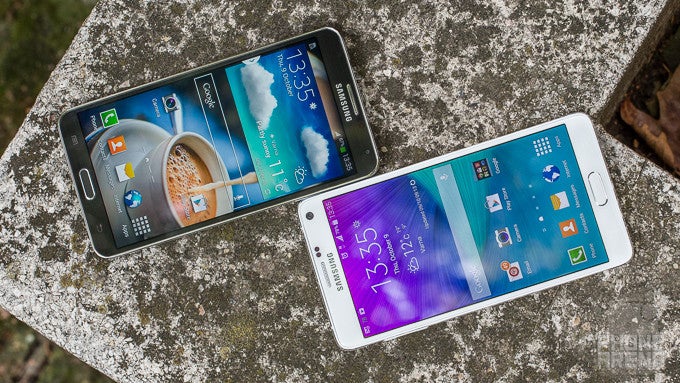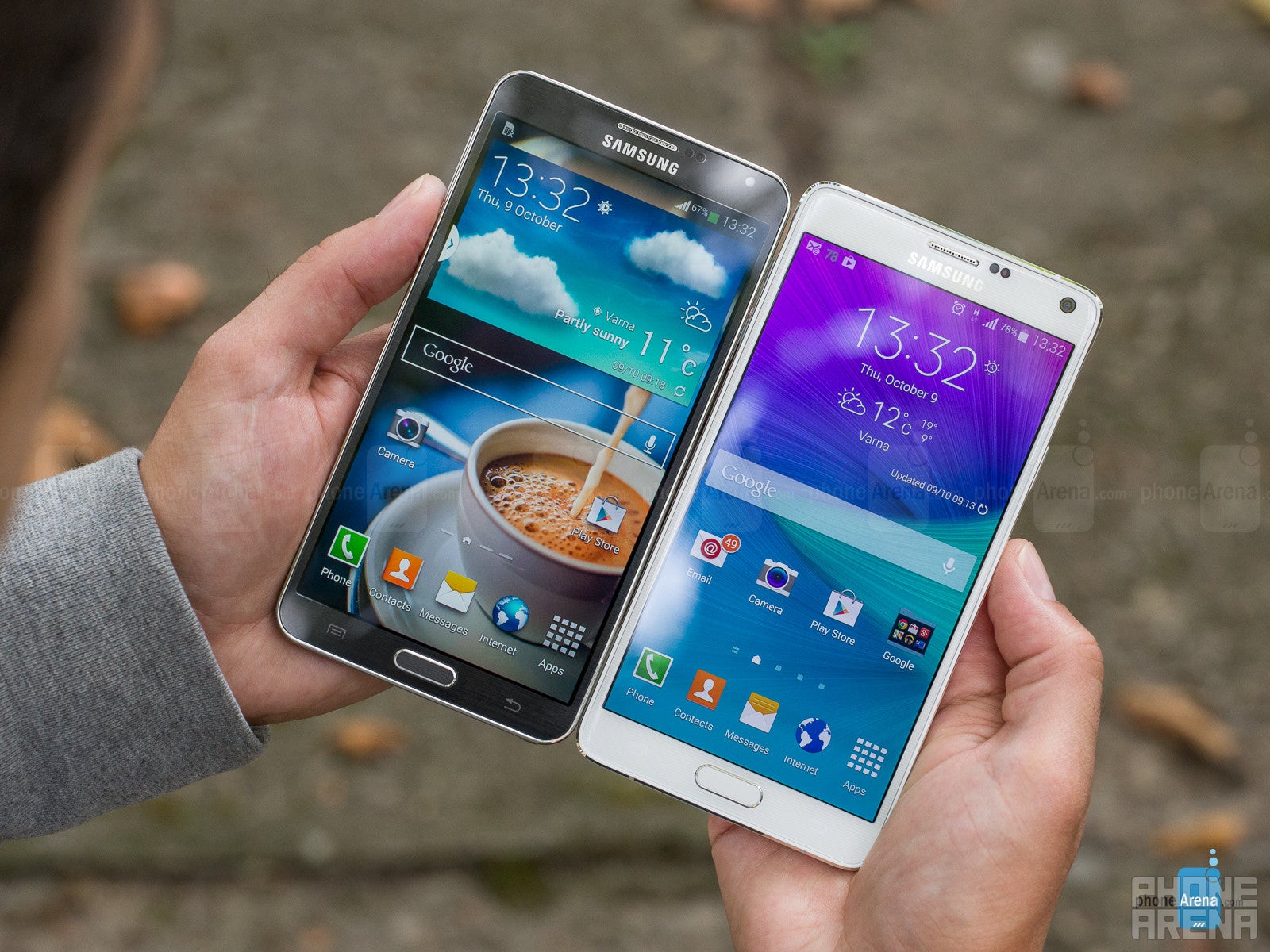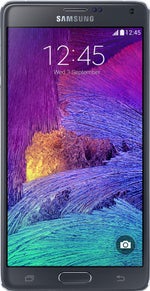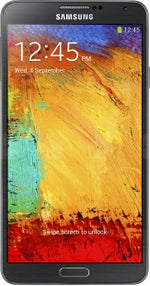Samsung Galaxy Note 4 vs Samsung Galaxy Note 3

Introduction
The Samsung Galaxy Note 3 is one of the finest smartphones we saw last year, and we have to say, it held its own pretty well throughout 2014. But the time has come for a better, faster, and stronger heir to stand up and announce its immediate appointment. The Galaxy Note 4 is every bit as good as its predecessor, only better in every regard. Samsung had to go far and out to ensure the Galaxy Note remains the king of phablets. A direct comparison with its powerful predecessor is a good way to find out whether the Galaxy Note 4 is up for the challenge.
Design
Subtle, but impossible to miss refinements make the Galaxy Note 4 the most beautiful one in the series.
The Galaxy Note 4 represents a subtle, but impossible to miss refinement of the Samsung Galaxy Note 3's design. For example, its looks have become more aesthetically pleasing. Instead of dull and flat, the front panel is more sporty and vibrant, and the aluminum frame is not merely something for the plastic to hold on to, but a finely sculpted design detail. The faux leather texture on the back panel stays in the Galaxy Note 4, although it looks classier now that the tacky fake stitching is removed.
The button placement remains unchanged. In both devices, the power key is positioned to the right, while the volume buttons are found on the left. The Home button, positioned in the center of the bottom bezel, looks about the same, although the one in the Galaxy Note 4 houses a fingerprint reader, as with the S5. It is accompanied by the multitasking capacitive key to the left, and the Back capacitive key to the right. And to the lower right, of course, you will find the Galaxy Note's specialty - the S-Pen slot.
Talking about the S-Pen, the stylus itself is 99% identical between the two devices, with only minor cosmetic differences to account for. Notably, the one in the Galaxy Note 4 is significantly easier to take out of its slot – it simply slides in and out. The one in the Galaxy Note 3 required a much tighter grip and pull.
Which phablet is easier to handle? That's pretty hard to say. The Note 4 is taller (by 0.09 inches or 2.28mm), slightly thicker (by 0.008 inches or 0.2mm) and heavier (by 0.28 oz or 8 grams), but it is 0.03 inches (0.76mm) narrower than its predecessor. These tiny differences don't account for a noticeable improvement or decline in ergonomics, and the sameness between build materials makes both phones feel equal in the hand – large, solid and rectangular.
Display
Past mistakes are forgiven! The Galaxy Note 4 has higher resolution and is super color-accurate.
Putting the Galaxy Note 3's 5.7-inch 1080p Super AMOLED display against that of the new Galaxy Note 4 shows how much Samsung managed to improve its AMOLED technology. The Note 4 display has the same 5.7-inch diagonal, but its resolution has been bumped to QHD (1440x2560). This results in a higher pixel density of 515 pixels per inch (ppi) compared to the Galaxy Note 3's 386 ppi. Thanks to this, the Galaxy Note 4's display appears sharper, its individual pixels impossible to spot with the naked eye from any viewing distance. The difference is not immediately apparent at first, because the Galaxy Note 3's display is still pretty sharp. But when the two phablets are put next to each other and viewed at a normal distance from the eye – say 16 inches (40cm) - the predecessor's screen seems a little blurry.
Resolution bump aside, picture quality is a huge area of improvement. In terms of accurate colors, the Galaxy Note 4 is the first Samsung phone to really have such. The Note 4's standard color temperature is a wildly impressive 6667 Kelvins - a hair's distance from the reference level of 6500 Kelvins. The Note 3, in comparison, verges far into the realm of cold colors with its temperature of 7972 Kelvins. The Galaxy Note 4 screen's color and grayscale errors are minimal, while the Note 3 has overblown colors and greenish look, that may wow somebody, but is pretty inaccurate. Note 4 not only has the most color-accurate AMOLED phone display, but also one of the best phone displays at all. However, if we nitpick, we must note the gamma level - the Galaxy Note 3, which measures 2.25, is almost on point with the preferred Gamma value of 2.2, while the Galaxy Note 4 measures a lower 1.97 gamma value. However, the lower gamma of the Note 4 is the result of brighter highlights only, with the shadows remaining as dark as they should be. This means that the screen ends up being a bit punchier and more contrasty than normal, though the effect is not so overdone as to be annoying or distracting. And it is still presents a much more realistic, color-accurate view than the Galaxy Note 3.
Finally, let's have a look at how the two displays perform outdoors and indoors. Pleasant outdoor usage requires a bright display covered with high quality, non-reflective glass. Both phablets are covered with high-quality glass that isn't overly reflective, so we have this part sorted out. But what about brightness levels? Although the Galaxy Note 3's display is reasonably well visible under direct sunlight, its maximum brightness level of 360 nits is surpassed by the 468 nits its successor is capable of. This means you will have a much easier time seeing and operating the Note 4 outdoors in the sun than its predecessor.
Bedtime reading requires a very low level of brightness to not strain your eyes. Both phablets fare very well in this regard, as the Galaxy Note 3 gets down to 4 nits of luminance, while its successor can muster a terrific 1 nit, ensuring a very comfortable night reading experience.
Interface and functionality
The Galaxy Note 4's revamped TouchWiz and even more S-Pen functionality make the Galaxy Note 3 seem outdated.
Samsung's TouchWiz remains one of the most fully featured Android user experiences. The Galaxy Note 4 enjoys a few new additions over its predecessor, mostly centered around the eponymous S-Pen. "Smart Select - Capture & Share" lets you capture and share different types of information – such as text, images, and links at once by simply dragging the stylus across the content you want to catch. It gets automatically selected and stored in a “container” of sorts, of which you choose the content you need and do what you want with it. "Smart Select - Link to related apps" makes transferring information between open apps very easy. For example, drag a photo of a favorite location to an e-mail, then drag its precise coordinates from Google Maps in the message body, arrange an event with an exact date and time together with your contacts, and add this information from Messages or the e-mail client to the Calendar. There's also Photo Note - it lets you create editable notes from photos of physically written text - say something on a piece of paper.
There are some odd tidbits lurking in the vast caverns of the Galaxy Note 4's interface - such as a blood oxygen level meter - but not all markets will be getting this “essential” nugget. However, the Galaxy Note 4 has fingerprint and heart-rate sensors - and therefore tighter security and integration with the S-Health app. As a whole, the revamped visual language and improved efficiency of the S-Pen make the Galaxy Note 3 - still a very adept phablet - seem a little dated in comparison.
Processor and memory
Thanks to its more recent hardware, the Galaxy Note 4 is quite a bit faster than its predecessor.
Another year, another push towards more powerful hardware. The Galaxy Note 4 takes on its predecessor with a faster processor - the Snapdragon 805 - clocked at an imposing 2.7GHz, paired with a graphics unit - the Adreno 420 - that's estimated to be 40% more powerful. Memory-wise, it still has a spacey 3GB of RAM, along with 32GB or 64GB of storage plus microSD slot. The added hardware beef, however, doesn't necessarily make the Galaxy Note 4 feel especially faster in daily usage scenarios like browsing and gaming, because powering the extremely sharp QHD display takes quite a bit of processing grunt.
Still, you will notice that the Note 4 can be quite a bit faster than its predecessor in benchmarks such as AnTuTu, where the phablet acquired a very impressive 41,185 points - a steady 9642 points increase over the Galaxy Note 3's result of 31,543 points.
What about the Galaxy Note 3? It still stands strong, showcasing the best of last year's flagship hardware. It runs on a quad-core Snapdragon 800 processor clocked at 2.3GHz, paired with an Adreno 330 GPU, 3GB of RAM, and 32GB or 64GB of expandable flash storage. This hardware profile packs enough power to play recent games and allow the phablet to operate reasonably quickly.
Internet and connectivity
The Note 4's cutting-edge chipset readies it for the super-fast LTE Cat. 6 Internet of tomorrow.
Different visual styling aside, the stock browser in the Galaxy Note 4 doesn't appear much different in terms of functionality over the Note 3's. The app remains reasonably fast and unobtrusive, and offers a neat Tab manager that lets you sort through tabs much like you scroll through apps in the Task Manager. There isn't much functionality to stand out.
Thanks to its cutting-edge chipset, the Galaxy Note 4 is ready to adopt the super-fast LTE Advanced Cat. 6 standard, which allows a theoretical maximum of 300Mbit/s download and 50Mbit/s of uplink. There's also HSDPA+ 42.2Mbit/s support, along with HSUPA, EDGE, and even ancient GPRS networks.
Its predecessor, the Galaxy Note 3, is left with LTE Cat 4, with a theoretical downlink speed of 150Mbit/s and 50Mbit/s uplink speed. The network support is identical. Both phablets have GPS and Glonass navigation support, along with 5GHz Wi-Fi 802.11 and Bluetooth 4.0 connectivity.
Camera
With a a bigger 16MP sensor, improved colors, and detailed low-light photography, the Galaxy Note 4 is a better cameraphone than its predecessor.
The Galaxy Note 4 received a substantial upgrade in the photography department over its predecessor in the form of a 16MP camera sensor. Samsung opted for a 1/2.6”sensor with f2.2 lens aperture and 1.12 micron pixel size. All of this sounds very similar to the camera sensor found in the Galaxy S5. The Galaxy Note 3, on the other hand, has a smaller 1/3.2-inch sensor, but as it is 13MP one, it comes with the same 1.12 micron-sized pixels as the Note 4. The pixel size ultimately determines how much light - respectively, visual information, the camera can take in. A camera sensor with a pixel size of 1.5 microns, such as the one found in the Apple iPhone 5s, for example, can capture almost 90% more light than both Galaxy Notes, despite their larger megapixel count.
That aside, the Galaxy Note 4 has an important new feature - optical image stabilization, a first time for Samsung. This is a technology that physically compensates for sudden camera movements, such as shaky hands. The Galaxy Note 3 has a software image stabilization algorithm only.
The Galaxy Note 4 has a better front camera too – it's a 3.7MP unit, while the Galaxy Note 3 has a 2.1MP unit. Thanks to the larger sensor, the former takes better, more detailed pictures, and you look livelier in video chats.
It comes as no surprise that the Galaxy Note 4 takes better photos than its predecessor. Photos from the 16MP camera are bigger, sharper, better exposed, and more detailed than the Galaxy Note 3's already impressive achievements in smartphone photography. One significant area of improvement is the color balance - unlike the Galaxy Note 3, which went a little overboard with the blue hues and made for a cold, sanitary look to the photos, the Galaxy Note 4 dials up the warm red levels, making outdoor photos more natural and pleasant.
Outdoors at night, the Galaxy Note 4 soaks in quite a bit more light than the Galaxy Note 3, which results in more visible illuminated details at the expense of overexposure. Photos taken by the Galaxy Note 3 look decidedly darker and noisier in comparison. They are also much softer, while the Galaxy Note 4 retains fairly sharp detail. Low-light photography has seen a big improvement in the new phablet, and by dialling down the exposure setting a notch, you will emerge with more usable night photos than before.
Indoors, the phablets take relatively noise-free pictures even in low lighting, although the Galaxy Note 4 is prone to severely overdoing the red hues in such conditions. When the flash is used, though, both phablets are on par in terms of lighting, with the Galaxy Note 4 providing sharp detail in contrast to the smoothness given by the Galaxy Note 3.
Surprisingly, though, despite the Galaxy Note 4's faster hardware, its camera is a tiny bit slower to take a photo, and it performed worse in the Camspeed benchmark than that of its predecessor. Still, both smartphones are very quick to open the camera app, focus, and take a photo. The Galaxy Note 4's redesigned camera interface contributes additional “speed points” as well, because it is much more streamlined and less cluttered than that of its predecessor.
Despite that, it's more feature-rich as well. There's a new shooting mode, called "Rear-cam selfie" - it allows you to take a high-quality 16MP selfie by letting the app determine the position where your face is, then automatically focus on your face and take the photo. Taking selfies an additional step further, the Note 4 boasts the Selfie panorama mode, which is inspired by that Twitter-iffic Ellen selfie at the Oscars. No, it doesn't render fake Holywood stars around you, it merely takes an extra-wide selfie that fits all the faces around yours.
Now, what about video quality? Both Galaxy Notes can shoot videos at a maximum 4K resolution. Thanks to the improved camera sensor, 4K video portrays even more precise detail than before, which the added optical image stabilization helps retain. The combination of 4K and OIS makes for a very compelling smartphone camera that even video enthusiasts should appreciate. However, due to the size and power constraints imposed by the demanding format, most of the time you will be shooting regular 1080p video at 60 frames per second. This is a task that both phablets execute equally well. There are no strikingly obvious improvements or degradations in image quality between the two.
Multimedia
The display makes all the difference. The loudspeaker – not really.
The Galaxy Note 4 offers a superior multimedia experience by virtue of its wonderful display. There's nothing like enjoying your photos and videos on a color-accurate, pin-sharp display - qualities that the year-old Galaxy Note 3 sadly doesn't stand up to.
Despite the revamped interface of the music and video apps, not much has changed within the Galaxy Note 4's players. High-definition audio and video playback is still on-board, and so is the valuable option to switch between different viewing modes that best suit your content - be it browsing, gaming, or movies.
Alas, the Galaxy Note 4's loudspeaker doesn't see much of an improvement over the Galaxy Note 3's. While we measured it as being 9dB louder, the single mono speaker on the Note 4's back panel still sounds thin and lacking in warmth. Like the Note 3's, it still sounds clear and loud enough to be heard over room noise, but it's hardly good enough for playing music. Hopefully, the next Galaxy Note 5 will finally step in the realm of dual front-facing speakers.
Call quality
The Galaxy Note 4 brings out your voice's natural timbre, while its predecessor makes it sound a tad robotic.

Battery
The Galaxy Note 3 delivers 6 hours of 8 minutes of on-screen time. Meanwhile, stay tuned for our Galaxy Note 4 battery test!
Although they have markedly different hardware, both phablets are serviced by mostly equal battery units - 3220mAh for the Note 4, and 3200mAh for the Note 3. We're yet to put the former through our battery test, but the results are coming soon! We expect the Galaxy Note 4 to perform admirably, perhaps even stretching its life into a full 8-hour workday. As for the latter, according to our measurements, it offers 6 hours and 8 minutes of on-screen time. Both phablets have removable back covers, so swapping an empty battery for a fresh unit is not a problem.
Conclusion
There's hardly anything unlikeable about the Galaxy Note 4, but upgrading from last year's Note 3 is up to you.
Unsuprisingly, the Galaxy Note 4 is a better phablet than its predecessor in every regard. It has a nicer build, an incredible display, a faster processor, revamped interface and enhanced functionality, along with a better camera, and a slightly longer battery life. If you are a fan of big-screen phones, and the Galaxy Note line in particular, there's hardly anything unlikeable about the fourth-generation Galaxy Note.
If specs, looks, and an enhanced S-Pen don't compel you into upgrading from the Galaxy Note 3, that's perfectly reasonable. However, if you are still rocking the good old Galaxy Note 2, then we think you are going to have a much better time with its heir from 2014.

Follow us on Google News
























Things that are NOT allowed:
To help keep our community safe and free from spam, we apply temporary limits to newly created accounts: